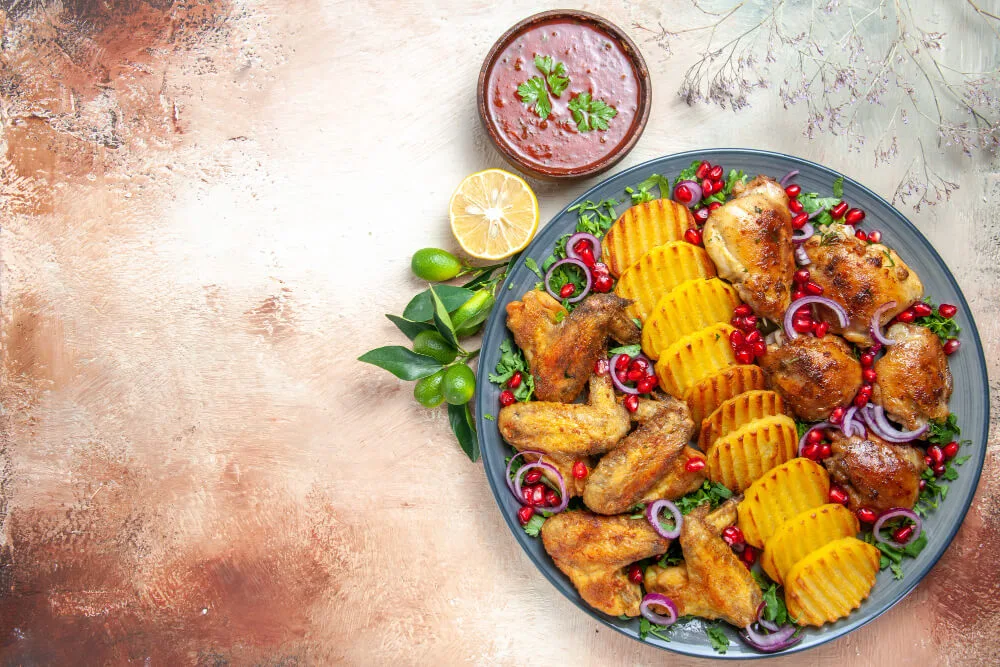New food trends are reshaping the culinary landscape at an unprecedented pace, with the global market projected to exceed $4 trillion by 2030, growing at a steady 10-11% annually. The dining experience as we know it is transforming before our eyes, driven by evolving consumer preferences and technological innovations.
As we look ahead to 2025, health-conscious dining remains on the rise, and sustainability has become essential with 85% of consumers willing to pay a premium, averaging around 9.7%, for sustainably sourced goods . Moreover, takeout now accounts for approximately 75% of restaurant traffic, reflecting a significant shift toward off-site dining.
In this comprehensive guide, we’ll explore the new restaurant trends 2025 has in store, from functional foods and smaller portions to technology-driven experiences and sustainability initiatives that are reshaping how we dine, cook, and experience food.
The Rise of Functional and Health-Driven Foods
Health and nutrition have emerged as dominant forces shaping restaurant menus, with consumers increasingly viewing food as medicine. In India, 53% of consumers say they proactively take steps to improve their health and wellness, and 64% prioritize transparency in ingredient information (Six in 10 U.S. consumers now agree that food can be “as powerful as medicine”), driving a fundamental shift in the food industry. This growing movement toward functional foods—products offering health benefits beyond basic nutrition—has captured the attention of nearly three-quarters of global consumers.

Adaptogens, probiotics, and fermented ingredients
The restaurant industry is embracing adaptogens—natural substances that help the body manage stress and restore balance. These powerful ingredients include:
- Ashwagandha: Reduces anxiety and improves sleep quality
- Reishi mushrooms: Promotes calmness and supports immune function
- Rhodiola Rosea: Enhances focus and stamina
- Holy Basil (Tulsi): Balances cortisol levels and supports mood
- Maca Root: Boosts energy and helps regulate mood swings
Fermented foods are similarly gaining traction on menus nationwide. Research from Stanford shows that a 10-week diet rich in fermented foods can boost microbiome diversity and improve immune responses. Consequently, restaurants are incorporating ingredients like kimchi, kombucha, and fiber-packed prebiotics into their offerings.
SunLife, an early adopter of this movement, has been offering smoothies, juices, and coffees using adaptogens since opening day. Meanwhile, in New York, Honeybrains developed recipes in consultation with neurologist Dr. Alon Seifan, featuring brain-boosting food groups and herbal ingredients.
High-protein and fiber-rich menu items
Protein continues to dominate health and nutrition trend lists, with consumers seeking convenient high-protein options to support healthful lifestyles, energy levels, weight loss, and activity recovery. This trend is reflected in sales data— India’s protein supplements market reached about USD 860 million in 2024, and the total protein market is estimated at USD 1.52 billion in 2025 (Global/U.S.: products with more than 20 grams of protein per serving topped $413.46 billion), growing 9.3% for the year ended October 8, 2024.
Restaurants are responding with innovative protein-forward dishes. At the Academy of Nutrition and Dietetics Food and Nutrition Conference and Expo (FNCE), high-protein convenience foods ranged from chickpea-based mac & cheese and pizza to breaded chicken, frittata bites, and sausages.
Furthermore, protein paired with fiber creates a “nutritional power couple” for satiety. Dishes combining whole grains, legumes, and lean proteins are particularly effective—for instance, chicken fajita bowls with black beans and bulgur provide approximately 15g fewer carbs and twice the fiber per cup than versions made with brown rice.
Health experts recommend meal plans delivering at least 76 grams of protein and 31 grams of fiber daily to support satiety and reduce inflammation. Restaurants offering these nutrient-dense combinations are seeing increased customer satisfaction and loyalty.
Functional beverages and wellness drinks
the functional beverages market was valued at about USD 6.20 billion in 2024 and is projected to reach USD 16.25 billion by 2033 (CAGR ~11.3%), driven by probiotics and energy drinks (U.S.: 39% of beverage sales are health/wellness, 80% of consumers want more functional drinks)
Precision Wellness, identified by Innova as one of the top influencing trends in 2025, is driving consumers to seek specific ingredients for targeted nutritional needs. Beverages that support focus, hydration, energy, immunity, and digestion are particularly popular, with many consumers desiring “benefit stacking”—drinks that deliver multiple functional benefits simultaneously.
Iced tea serves as an excellent platform for functional innovation, containing L-theanine, a nootropic that creates a synergistic effect with caffeine for sustained energy and focus without jitters. Cold brew coffee consumption has increased 300% in seven years, primarily driven by Gen Z, making it another ideal candidate for functional enhancement.
Wellness beverages are evolving beyond basic energy drinks to include ingredients supporting hydration, blood sugar balance, and mood enhancement. Kombucha, herbal teas, and protein-infused drinks are becoming mainstream offerings as restaurants capitalize on consumers’ growing interest in beverages that contribute to their overall wellbeing.
As health-conscious dining continues gaining momentum, restaurants that embrace these functional and health-driven food trends will position themselves for success in the competitive 2025 marketplace.
Smaller Portions, Bigger Variety
The dining landscape is experiencing a remarkable shift as smaller plates make a big impact on restaurant menus nationwide. Unlike traditional three-course meals, the small plate concept offers diners the freedom to sample multiple dishes in one sitting, creating a more dynamic and interactive eating experience.

Why small plates are trending
The tapas revolution, which began in the mid-1980s with Spanish small plates, has evolved into one of the largest macro trends in the food industry today. This movement initially captured the imagination of foodies who discovered they could order an assortment of dishes to share around the table, marking what industry experts call “a sea change” in dining culture.
Millennials are now the primary drivers behind this trend, In India, the food services market stood at ₹4–5 lakh crore in 2023 and is projected to reach ₹9–10 lakh crore by 2030, with the average meal for two costing under ₹300 (U.S.: Millennials spending approximately $246,475 annually) on eating out, with 44% of their food dollars devoted to restaurant experiences. For this generation, food represents more than mere sustenance—it’s entertainment and self-expression. What could be more satisfying than selecting a curated collection of dishes to enhance a social outing?
Moreover, restaurants find smaller plates financially advantageous. In India, the average restaurant meal for two costs under ₹300 (~USD 4), though small-plate/tapas-style pricing is not separately reported (U.S./Europe: Tapas-style average check ~$65 [£65 or ₹4,640], plates $7–20 [₹506–₹1,518]), with individual plates ranging from $7-$20 (₹506-₹1,518). This pricing structure often results in higher overall spending as diners order multiple dishes throughout their experience.
Impact on food waste and sustainability
When we waste food, we waste the labor, effort, investment and precious resources that go into producing it, including water, seeds, and feed. Smaller portions directly address this environmental concern by reducing plate waste that has unfortunately become habitual for many diners.
According to the Food and Agriculture Organization, taking smaller portions at home or sharing large dishes at restaurants represents an effective strategy for becoming a “Food Hero” and reducing unnecessary waste. Restaurants implementing wise portion sizing find it enhances customer satisfaction while significantly reducing discarded food.
By offering multiple portion options—half-portions, small plates, or customizable serving sizes—establishments can cater to different appetites and dietary preferences. This flexibility gives diners more control over their meal choices and helps prevent excessive plate waste.
How it supports social and shared dining
The shared dining concept creates a distinctly different atmosphere from traditional restaurant experiences. It promotes deeper connection between people at the table, fostering a sense of community that many find increasingly valuable in our fast-paced, individualistic world.
As one industry observer notes: “I love trying lots of different flavors, and small plates allow for that”. This sentiment reflects the growing desire for variety and exploration in dining experiences. The communal aspect of sharing multiple dishes encourages conversation and interaction as diners discuss the various flavors and presentations.
This trend has evolved beyond tapas to include diverse culinary traditions:
- Mediterranean meze platters
- Asian dim sum and shared bowls
- American gastropub shareable appetizers
- Modern international fusion small plates
Restaurants are redesigning their spaces to accommodate this trend, with many introducing communal tables where the bustling energy permeates every corner of the establishment. The physical layout supports the concept of “New Sharing”—a return to traditional communal eating deeply rooted in many cultures and families.
Looking toward 2025, this movement toward smaller, shareable portions shows no signs of slowing down, as it perfectly aligns with evolving consumer preferences for variety, social connection, and sustainable dining practices. Therefore, restaurants that embrace this concept position themselves to meet the demands of contemporary diners seeking both culinary exploration and meaningful shared experiences.
Locally Sourced and Seasonal Ingredients
The farm-to-table movement has evolved from a niche concept into one of the defining food industry trends of 2025. Restaurants across the globe are fundamentally rethinking their supply chains, prioritizing ingredients grown in their immediate surroundings rather than those shipped from distant locations.

Supporting local farmers and reducing carbon footprint
In 2025, restaurants are increasingly partnering with local farmers, urban rooftop gardens, community-supported agriculture programs, and even implementing in-house hydroponic systems. This shift toward hyperlocal sourcing isn’t merely trendy—it creates tangible environmental benefits. In India, road transport contributes about 12% of energy-related CO₂ emissions, with vehicles accounting for 13% statewide in Gujarat and up to 36% in Ahmedabad and 52% in Rajkot (U.S.:Transportation accounts for approximately 29% of emissions ), with medium and heavy-duty trucks responsible for 23% of that total.
Nevertheless, it’s worth noting that the environmental impact varies significantly by food type. Despite what many assume, transport typically accounts for less than 1% of beef’s greenhouse gas emissions, making the type of food consumed generally more important than its origin. However, air-freighted foods represent an exception to this rule—they emit 50 times more CO2 than boat-transported goods per ton kilometer.
Restaurants practicing hyperlocal sourcing typically experience additional benefits beyond environmental considerations:
- Greater control over ingredient quality and consistency
- Reduced supply chain disruptions
- Stronger community relationships
- Fresher, more nutrient-dense produce
Seasonal menus and regional flavors
Seasonal dishes have become a cornerstone of modern gastronomy, characterized by fresh, regional products that offer both culinary excellence and environmental consciousness. Chefs embracing this trend draw inspiration directly from nature’s cycles, adapting their menus to showcase ingredients at their peak flavor and nutritional value.
Certainly, the most forward-thinking establishments have moved beyond merely sourcing from farms—they’re integrating completely with agricultural systems. Take Farmlore, for instance, where the entire 37-acre property functions as an agricultural ecosystem. Unlike conventional restaurant-supplier relationships, their menu is genuinely dictated by what’s growing rather than what’s trending.
This approach to “extreme seasonality” creates unique dining experiences tied to specific farm conditions at that moment. Through this practice, seasonal and local ingredients become foundational to sustainability efforts, minimizing transportation needs and refrigeration requirements while ensuring the freshest, most flavorful meals.
Transparency in sourcing and storytelling
Today’s diners expect unprecedented transparency regarding their food’s origins. Approximately 67% of consumers want detailed information about every ingredient in the products they purchase. The pandemic has only intensified this concern, with more people becoming vigilant about their health and consumption choices.
Essentially, transparency opens doors to culinary innovation and community collaboration. Restaurants sharing ingredient information often discover opportunities to partner with local farmers, producers, and artisans. This collaborative spirit supports local businesses and creates unique, sustainable dining experiences.
Successful implementation strategies include:
- Creating signage or menu notations highlighting locally sourced foods
- Building strong supplier relationships through regular communication
- Collaborating with industry organizations focused on supply chain transparency
- Ensuring all staff can confidently discuss ingredient origins with guests
Beyond building trust, these practices create meaningful connections between diners and their food. Guests don’t just consume meals—they experience the entire journey from soil to plate, often beginning with literal walks through the farm that informs everything that follows.
Personalized Dining Experiences
Personalization is emerging as a hallmark of the dining revolution, with restaurants crafting unique experiences tailored to individual preferences. Today’s diners expect more than just good food—they want experiences that reflect their personal tastes and dietary needs.

AI-powered menu customization
Gone are the days of one-size-fits-all menus. Restaurants are now harnessing data and AI to create hyper-personalized dining experiences that analyze guest preferences, dietary restrictions, and past dining habits. This advanced customization addresses a growing problem: menu anxiety. Indeed, according to recent studies, 86% of Gen Z adults experience anxiety when facing static, overwhelming menu options.
Smart personalization helps restaurants serve relevant content that makes customers’ lives easier—even for decisions as simple as selecting the right side dish. The technology can suggest plant-based options for vegans or configure menu boards to feature items popular with similar consumers. Primarily, this reduces information clutter, streamlines the journey, and prevents decision paralysis while creating more satisfying and memorable experiences.
Many establishments are embracing technology to:
- Collect and utilize data about customer preferences
- Offer tailored menu suggestions based on past orders
- Prevent suggesting out-of-stock or unpopular items
- Create personalized promotions and recommendations
Chef’s tables and exclusive menus
Chef’s tables represent the ultimate personalized dining experience. Originally an invitation-only VIP perk where chefs entertained family and friends in the kitchen, this concept has evolved into fully bookable experiences for the general public. These exclusive settings offer diners meaningful interactions with head chefs that would be impossible in main dining rooms.
“Speaking from the heart, I believe that a chef’s table must sit inside the kitchen,” notes one renowned chef. “The best moments are when guests can see and hear and feel the kitchen life”. Subsequently, these intimate experiences allow chefs to adjust menus based on guest preferences—if someone mentions liking bell peppers, the kitchen can incorporate this preference into their meal.
The chef’s table concept offers an immersive culinary journey where guests witness culinary artistry firsthand. Typically, these experiences include customized tasting menus crafted by the head chef, featuring seasonal ingredients, signature dishes, and unique creations not available on the regular menu.
Dietary-specific offerings (gluten-free, keto, etc.)
As dietary awareness grows, restaurants are expanding their menu options to accommodate specific needs. A study found that among the five most frequently appearing alternative diets on restaurant menus (gluten-free, low-calorie, low-carb, low-fat, and vegetarian), gluten-free options comprised the largest proportion at 9.8% of all menu items.
Although the prevalence of celiac disease ranges from less than 1% to 4.5% of the population, approximately 15-25% of consumers seek gluten-free items for health and weight purposes—a demand the restaurant industry has clearly responded to. In India, about 38–39% of adults identify as vegetarians (U.S.: 2–5% of adults are vegetarian; menus include 3.6% vegetarian items).
Keto-friendly restaurants have likewise expanded nationwide. For those following this low-carb, high-fat diet (typically limiting daily carb intake to 50 grams or fewer), many establishments now offer options beyond bunless burgers and grilled chicken salads. Hence, restaurants with specific dietary menus frequently highlight their offerings with labels like “keto options,” “vegetarian friendly,” “sugar-free options,” and “gluten-free options”.
Plus, these alternative diet items typically have healthier nutrient profiles compared to non-diet items—for example, gluten-free small plates have nearly 500 fewer milligrams of sodium than their conventional counterparts.
First and foremost, personalization is reshaping the dining landscape of 2025, creating experiences as unique as the diners themselves.
Sustainability as a Core Value
Sustainability has transformed from a buzzword into a business imperative, with 17% of all food available at consumer level being wasted. This staggering statistic has prompted a fundamental shift in how restaurants approach their environmental responsibilities.

Eco-friendly packaging and zero-waste kitchens
Forward-thinking restaurants are embracing the “five Rs” methodology to create zero-waste kitchens: refuse single-use plastics, reduce resource consumption, reuse creatively, recycle comprehensively, and rot through composting. These principles guide operations from procurement to disposal.
Notably, eco-friendly packaging solutions have evolved beyond basic recyclables. Innovative materials made from sugarcane bagasse (residual pulp) are gaining popularity as 100% compostable alternatives that can decompose in backyard composting systems. These products range from plates and bowls to takeout containers, offering oil-resistant, microwave-safe, and freezer-safe alternatives to traditional packaging.
Energy-efficient appliances represent another cornerstone of sustainable kitchen operations. Modern commercial equipment can reduce energy consumption by up to 60% while maintaining or improving performance. Such investments not only decrease environmental impact but ultimately improve cost-effectiveness.
Plant-based fine dining and lab-grown meat
In India, the plant-based meat market stood at USD 98.6 million in 2024 and is projected to reach USD 737.9 million by 2033 (CAGR ~22.3%); cultivated meat is not yet approved, though the FSSAI is developing regulations (U.S.: Upside Foods and Good Meat have regulatory approval to sell cultivated chicken in restaurants).
Concurrently, cultivated meat (lab-grown from animal cells) is making its restaurant debut. Companies like Upside Foods and Good Meat received regulatory approval to begin selling cultivated chicken products in high-end restaurants. Although currently produced at small scales in two-liter vessels, the technology promises significantly reduced environmental impact as production methods scale up.
Consumer demand for ethical practices
Ethical dining practices have become non-negotiable for many consumers, who increasingly value restaurants committed to sustainability, animal welfare, and fair trade. Restaurants are responding by implementing waste reduction strategies and partnering with organizations to donate leftover food.
Alongside waste reduction, transparency in sourcing has become paramount. Establishments that clearly communicate their sustainability initiatives build trust with environmentally conscious diners. As 2025 approaches, restaurants integrating these practices position themselves not just as food providers but as responsible community members addressing our most pressing environmental challenges.
Technology Reshaping the Restaurant Experience
Technology is fundamentally transforming the restaurant landscape in 2025, with innovations that enhance both operational efficiency and customer experiences.

Smart ordering systems and robotic kitchens
Touch-based digital systems are replacing traditional pen-and-paper methods, allowing seamless order processing through QR codes displayed on tables. These contactless solutions eliminate wait times and reduce order errors, ultimately streamlining the dining experience.
Simultaneously, robotic kitchens are changing food preparation. Moley’s Robotic Kitchen replicates professional chef techniques with remarkable accuracy, executing recipes flawlessly through intricate sensors and motors. This innovation offers significant return on investment—approximately £40,000 annually compared to delivery or ready-made meals. Companies like White Castle and Wendy’s have already deployed robotic systems that reduce cooking time by 50%.
AR/VR dining and immersive experiences
Presently, restaurants utilize projection mapping to transform dining spaces, creating dynamic environments that change with each course. Augmented reality enhances menus, allowing customers to preview dishes in 3D before ordering. Virtual reality takes diners on journeys—transporting them to Tuscany while enjoying Italian cuisine or underwater adventures before seafood meals.
Beyond these technologies, 5D dining stimulates all five senses, exemplified by The X Pot in Las Vegas, where every surface, including tables, serves as a projection surface.
AI in inventory and staff management
AI-driven inventory systems predict demand, optimize stock levels, and reduce food waste. These systems analyze sales patterns, track ingredient expiration dates, and automatically reorder items when supplies run low.
Regarding staff management, AI algorithms analyze historical data to predict busy periods and suggest optimal staffing levels. Performance tracking identifies improvement areas, whereas virtual training provides immersive experiences for new employees.
Conclusion
Restaurant trends for 2025 reveal a fascinating shift toward dining experiences that balance technology with tradition, health with indulgence, and sustainability with innovation. These emerging trends will certainly reshape how we eat out in the coming years.
Functional foods and health-driven menu items stand out as major game-changers. Restaurants that integrate adaptogens, probiotics, and protein-rich options onto their menus will likely see increased customer loyalty from health-conscious diners. Additionally, the shift toward smaller portions offers multiple benefits—reduced food waste, enhanced social dining experiences, and greater menu variety for adventurous eaters.
The emphasis on locally sourced ingredients represents another powerful trend. Beyond environmental benefits, this practice creates meaningful connections between diners, farmers, and the food itself. Therefore, restaurants embracing transparency in their sourcing will build stronger community relationships and brand trust.
Personalization has transformed from a luxury to an expectation. Thanks to AI-powered menus and expanded dietary options, diners now expect experiences tailored specifically to their preferences and restrictions. Consequently, restaurants that fail to provide these customized experiences might struggle to remain competitive.
Sustainability has evolved from a marketing buzzword to a fundamental business value. Zero-waste kitchens, eco-friendly packaging, and plant-based options now represent standard practices rather than exceptional ones. The restaurants that thrive will be those that authentically commit to environmental stewardship.
Technology continues to revolutionize every aspect of dining—from ordering systems to immersive AR/VR experiences. Still, successful restaurants will balance these innovations with the human connection that makes dining out special.
While navigating these trends might seem challenging, they represent exciting opportunities for restaurants willing to adapt. The future of dining looks promising—more personalized, sustainable, healthy, and technologically enhanced than ever before, yet still centered around the timeless joy of breaking bread together.
Key Takeaways
The restaurant industry is undergoing a dramatic transformation in 2025, driven by health consciousness, sustainability demands, and technological innovation. Here are the essential insights every restaurant owner and food enthusiast should know:
• Health-driven menus are becoming mainstream – In India, 53% of consumers say they proactively take steps to improve their health and wellness, and 64% prioritize transparency in product information (U.S.: 60% agree food can be “as powerful as medicine”).
, driving demand for functional ingredients like adaptogens, probiotics, and high-protein options that deliver wellness benefits beyond basic nutrition.
• Small plates maximize variety and minimize waste – The tapas revolution continues expanding as diners seek diverse flavors in smaller portions, reducing food waste while creating more social, shareable dining experiences.
• Local sourcing builds community and cuts emissions – Hyperlocal ingredients from nearby farms and urban gardens reduce transportation emissions by up to 50x compared to air-freighted foods while ensuring peak freshness.
• Personalization prevents menu anxiety – AI-powered customization addresses the fact that 86% of Gen Z experiences menu overwhelm, offering tailored recommendations based on dietary needs and past preferences.
• Sustainability drives purchasing decisions – With 53% of consumers willing to pay 10% more for sustainable options, zero-waste kitchens and eco-friendly packaging have shifted from nice-to-have to business-critical.
• Technology enhances without replacing human connection – Smart ordering systems, robotic kitchens, and AR/VR experiences streamline operations and create immersive dining, but successful restaurants balance innovation with authentic hospitality.
The restaurants that thrive in 2025 will be those that authentically integrate these trends while maintaining the fundamental joy of shared dining experiences.
FAQs
Q1. What are some of the key restaurant trends expected for 2025?
Key trends include the rise of functional and health-driven foods, smaller portions with greater variety, locally sourced ingredients, personalized dining experiences, sustainability as a core value, and technology reshaping the restaurant experience.
Q2. How are restaurants incorporating health-conscious options into their menus?
Restaurants are adding adaptogens, probiotics, and fermented ingredients to dishes, offering high-protein and fiber-rich menu items, and creating functional beverages and wellness drinks to cater to health-conscious consumers.
Q3. Why are smaller portions becoming popular in restaurants?
Smaller portions allow diners to sample multiple dishes, reduce food waste, support social and shared dining experiences, and often result in higher overall spending as customers order a variety of items.
Q4. How are restaurants personalizing the dining experience?
Restaurants are using AI-powered menu customization, offering chef’s tables with exclusive menus, and providing dietary-specific options (like gluten-free and keto) to create more personalized experiences for diners.
Q5. What role does sustainability play in the restaurant industry of 2025?
Sustainability has become a core value, with restaurants focusing on eco-friendly packaging, zero-waste kitchens, plant-based fine dining options, and ethical practices to meet growing consumer demand for environmentally responsible dining.

